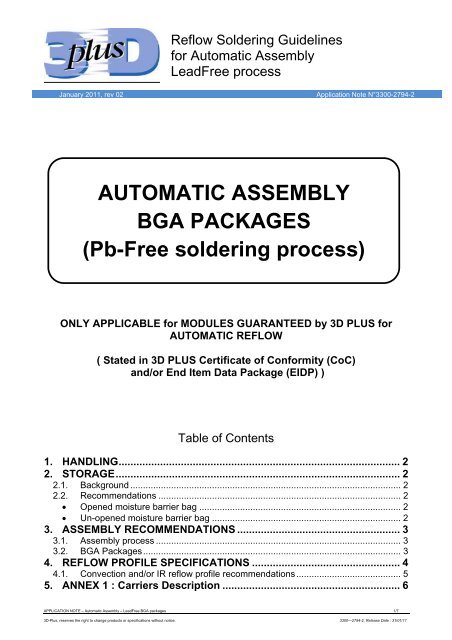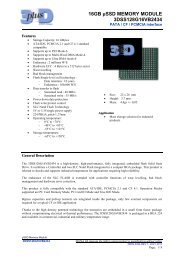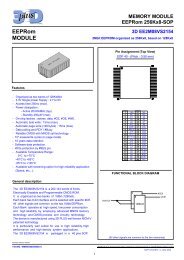AUTOMATIC ASSEMBLY BGA PACKAGES (Pb-Free ... - 3D Plus
AUTOMATIC ASSEMBLY BGA PACKAGES (Pb-Free ... - 3D Plus
AUTOMATIC ASSEMBLY BGA PACKAGES (Pb-Free ... - 3D Plus
You also want an ePaper? Increase the reach of your titles
YUMPU automatically turns print PDFs into web optimized ePapers that Google loves.
Reflow Soldering Guidelines<br />
for Automatic Assembly<br />
Lead<strong>Free</strong> process<br />
January 2011, rev 02 Application Note N°3300-2794-2<br />
<strong>AUTOMATIC</strong> <strong>ASSEMBLY</strong><br />
<strong>BGA</strong> <strong>PACKAGES</strong><br />
(<strong>Pb</strong>-<strong>Free</strong> soldering process)<br />
ONLY APPLICABLE for MODULES GUARANTEED by <strong>3D</strong> PLUS for<br />
<strong>AUTOMATIC</strong> REFLOW<br />
( Stated in <strong>3D</strong> PLUS Certificate of Conformity (CoC)<br />
and/or End Item Data Package (EIDP) )<br />
Table of Contents<br />
1. HANDLING ............................................................................................... 2<br />
2. STORAGE ................................................................................................ 2<br />
2.1. Background .......................................................................................................... 2<br />
2.2. Recommendations ............................................................................................... 2<br />
• Opened moisture barrier bag ............................................................................... 2<br />
• Un-opened moisture barrier bag .......................................................................... 2<br />
3. <strong>ASSEMBLY</strong> RECOMMENDATIONS ....................................................... 3<br />
3.1. Assembly process ................................................................................................ 3<br />
3.2. <strong>BGA</strong> Packages ..................................................................................................... 3<br />
4. REFLOW PROFILE SPECIFICATIONS .................................................. 4<br />
4.1. Convection and/or IR reflow profile recommendations ......................................... 5<br />
5. ANNEX 1 : Carriers Description ............................................................ 6<br />
APPLICATION NOTE – Automatic Assembly – Lead<strong>Free</strong> <strong>BGA</strong> packages 1/7<br />
<strong>3D</strong>-<strong>Plus</strong>, reserves the right to change products or specifications without notice. 3300—2794-2, Release Date : 31/01/11
Reflow Soldering Guidelines<br />
for Automatic Assembly<br />
Lead<strong>Free</strong> process<br />
January 2011, rev 02 Application Note N°3300-2794-2<br />
1. HANDLING<br />
Components manufactured by <strong>3D</strong> PLUS must be handled with care. Operators are<br />
requested to wear antistatic gloves and antistatic brackets.<br />
The use of tools that could damage sides of components is also prohibited.<br />
Note : Manual handling may increase the risk of mechanical and/or ESD damage.<br />
2.1. Background<br />
2. STORAGE<br />
The vapor pressure of moisture inside a non hermetic package increases greatly when the<br />
package is exposed to the high temperature of solder reflow. Under certain conditions, this<br />
pressure can cause internal delamination of the packaging materials from the die and/or<br />
leadframe/substrate, internal cracks that do not extend to the outside of the package,<br />
bond damage, wire necking, bond lifting, die lifting, thin film cracking, or cratering beneath<br />
the bonds. In the most severe case, the stress can result in external package cracks. This<br />
is commonly referred to as the ‘‘popcorn’’ phenomenon because the internal stress<br />
causes the package to bulge and then crack with an audible ‘‘pop’’.<br />
2.2. Recommendations<br />
In order to avoid degradation due to humidity, components must be handled according to<br />
the following procedure.<br />
• Opened moisture barrier bag<br />
Any duration exposure : Components which have been exposed only to ambient<br />
conditions of
Reflow Soldering Guidelines<br />
for Automatic Assembly<br />
Lead<strong>Free</strong> process<br />
January 2011, rev 02 Application Note N°3300-2794-2<br />
Note :<br />
High temperature Carriers : Unless otherwise indicated by <strong>3D</strong> PLUS, modules shipped in<br />
high temperature trays can be baked in the trays at 135°C or 150°C (see annex 1).<br />
Low temperature carriers : Modules shipped in low temperature carriers (e.g. plastic box,<br />
low temperature trays, tape and reel,...) may not be baked in the carriers at any<br />
temperature higher than 40°C. If a higher bake temperature is required, modules must be<br />
removed from the low temperature carriers to thermally safe carriers, baked, and returned<br />
to the low temperature carriers (see annex 1).<br />
3.1. Assembly process<br />
3. <strong>ASSEMBLY</strong> RECOMMENDATIONS<br />
After the sealed bag is opened, the maximum duration is 72 hours under environmental<br />
conditions
Reflow Soldering Guidelines<br />
for Automatic Assembly<br />
Lead<strong>Free</strong> process<br />
January 2011, rev 02 Application Note N°3300-2794-2<br />
Some products use Sn(10%wt)<strong>Pb</strong>(90%wt) solder ball alloy with melting point at 290°C ;<br />
the solder balls are not supposed to melt during reflow process.<br />
4. REFLOW PROFILE SPECIFICATIONS<br />
The characterization and optimization of the reflow process is the most important factor to<br />
be considered for lead free soldering. The reflow process window (RPW) for conventional<br />
soldering is relatively wide. The melting point of the solder alloy is 218°C to 221°C. The<br />
lower temperature limit for reflow is usually 230°C. The upper limit is 245°C, which is the<br />
maximum temperature that body package can be exposed to.<br />
These high and low temperature limits provide a process window of over 15°C.<br />
Note : The major factors contributing to the development of an optimal thermal profile are<br />
the size and weight of the assembly, the density of the components, the mix of large and<br />
small components and the solder paste chemistry being used. The reflow profiling should<br />
be performed by attaching calibrated thermocouples embedded in the spheres of the <strong>BGA</strong><br />
modules as well as other critical locations on the boards to ensure that all components are<br />
heated to temperatures above minimum reflow temperatures and that modules do not<br />
exceed maximum temperature limits.<br />
APPLICATION NOTE – Automatic Assembly – Lead<strong>Free</strong> <strong>BGA</strong> packages 4/7<br />
<strong>3D</strong>-<strong>Plus</strong>, reserves the right to change products or specifications without notice. 3300—2794-2, Release Date : 31/01/11
Reflow Soldering Guidelines<br />
for Automatic Assembly<br />
Lead<strong>Free</strong> process<br />
January 2011, rev 02 Application Note N°3300-2794-2<br />
4.1. Convection and/or IR reflow profile recommendations<br />
The reflow profiles studied and recommended by <strong>3D</strong> PLUS are based on experiences to<br />
ensure that all packages can be successfully and reliably assembled. The Figure 1 shows<br />
the range of temperature profiles and the table 1 lists the reflow parameters and peak<br />
temperatures as recommended by <strong>3D</strong> PLUS.<br />
Figure 1 : IR / Convection reflow profile<br />
Reflow parameter Sn-<strong>Pb</strong> Eutectic Assembly<br />
Minimum preheat temperature (TsMIN) 150°C<br />
Maximum preheat temperature (TsMAX) 200°C<br />
Preheat Time 60 to 120 seconds<br />
TsMAX to TL ramp-up rate 3°C/second maximum<br />
Time above temperature TL = 217°C (tL) 60 – 150 seconds<br />
Peak package body temperature (Tp) 245°C +5°C/-5°C maximum<br />
Time 25°C to TP<br />
6 minutes maximum<br />
Time within 5°C of peak TP<br />
20 – 30 seconds<br />
Ramp-down rate 6°C/second maximum<br />
Table 1: Lead<strong>Free</strong> reflow profile recommendation<br />
APPLICATION NOTE – Automatic Assembly – Lead<strong>Free</strong> <strong>BGA</strong> packages 5/7<br />
<strong>3D</strong>-<strong>Plus</strong>, reserves the right to change products or specifications without notice. 3300—2794-2, Release Date : 31/01/11
Reflow Soldering Guidelines<br />
for Automatic Assembly<br />
Lead<strong>Free</strong> process<br />
January 2011, rev 02 Application Note N°3300-2794-2<br />
5. ANNEX 1 : Carriers Description<br />
1. High temperature carrier description<br />
Plastic tray for modules<br />
For this tray, the maximum temperature is marked 150°C for Baking<br />
APPLICATION NOTE – Automatic Assembly – Lead<strong>Free</strong> <strong>BGA</strong> packages 6/7<br />
<strong>3D</strong>-<strong>Plus</strong>, reserves the right to change products or specifications without notice. 3300—2794-2, Release Date : 31/01/11
Reflow Soldering Guidelines<br />
for Automatic Assembly<br />
Lead<strong>Free</strong> process<br />
January 2011, rev 02 Application Note N°3300-2794-2<br />
2. Low temperature carrier description<br />
Plastic box for modules<br />
Low temperature plastic tray<br />
APPLICATION NOTE – Automatic Assembly – Lead<strong>Free</strong> <strong>BGA</strong> packages 7/7<br />
<strong>3D</strong>-<strong>Plus</strong>, reserves the right to change products or specifications without notice. 3300—2794-2, Release Date : 31/01/11

















